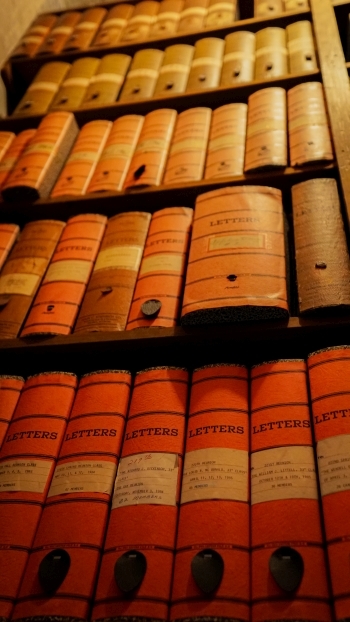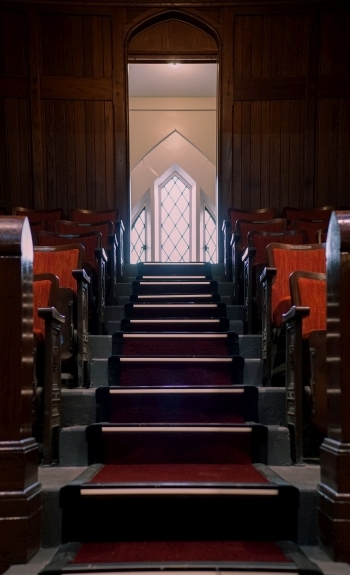Not far from where Interstate 74 slices through the heart of Peoria’s downtown, a commanding and magnificent structure looms near the entrance to the city’s North Valley neighborhood. With a distinct Gothic style inspired by the great cathedrals of Europe, its unique architecture has made it a standout in the downtown space for nearly a century. Yet even after all this time, many locals don’t know its story—and may never have set foot inside.
“This is a building not everyone had access to for most of its 100-year history,” explains Jenny Parkhurst from her office in the former Scottish Rite Cathedral. Parkhurst serves as executive director of performing arts for KDB Group, the development giant currently engaged in a wildly diverse slate of projects across central Illinois. In this role, she oversees all things taking place at the newly christened Scottish Rite Theatre, as well as the Betty Jayne Brimmer Center for Performing Arts in Peoria Heights.
Just how did such a grand structure come to be built here in Peoria? Set along a one-way street at the corner of Spalding and NE Perry, much of the surrounding property is traveled these days primarily by employees going to and from OSF Saint Francis Medical Center. Yet the Scottish Rite Theatre has received more public attention over the past few years than it had seen in several decades. In order to fully appreciate where the building is going in the future, unearthing the stories of its past is a necessity.

The Majestic Building
Inspired by the architecture seen in the European travels of planner Edward Ulysses Henry, the Scottish Rite was designed by the Hewitt, Emerson and Gregg architectural firm and constructed over a two-and-a-half-year period beginning in 1922, at a cost of $400,000. It was dedicated in front of a large crowd in January of 1925—a marvel of craftsmanship no longer seen in modern construction.
The majestic building was constructed to serve as the home of the Valley of Peoria Scottish Rite, the local chapter of Freemasonry, the world’s largest and oldest fraternal organization. According to their website, the Valley of Peoria is focused on fulfilling the Masonic obligation to care for its members, and that it seeks “to strengthen the community and believes that each man should act in civil life according to his individual judgment and the dictates of his conscience.”

Masonic symbols can be found throughout the building, a frequent motif of its design. One of the most prominent symbols depicts a double-headed eagle with the Latin phrase Spes mea in Deo est (“My hope is in God”), which serves as confirmation of their core values: reverence for God, devotion to country, integrity, justice, toleration and service. Also prevalent are quatrefoil patterns—Christian symbols believed to bring good luck—which are often found in Gothic architecture and underline many of the philosophies of Freemasonry.
While it can feel overwhelming to wander its imposing halls, you’ll soon discover the Scottish Rite is so masterfully designed that you really can’t get lost. The facility houses offices, meeting rooms, lounges and a large ballroom, but its primary feature is a vast auditorium that seats nearly 900 and houses a massive, Romantic-style Moller 3 pipe organ with 4,000 pipes. Here is where the Scottish Rite organization presents its degrees—in theatrical productions that are historical or biblically-themed in nature and which seek to teach or reinforce Masonic philosophies. These elaborate productions, performed for the membership, feature costumes, wigs and scenery. Members work their way through them hoping to complete all 33 of the honorary degrees. Besides these degree performances for members, the Scottish Rite presented its own biennial adaptation of A Christmas Carol to the public for decades, alongside spring productions of classic stage comedies such as Harvey and Arsenic and Old Lace.
Around the time of the building’s dedication, the Scottish Rite Bodies of the Valley of Peoria boasted a membership of nearly 3,500, eventually reaching a peak of around 10,000 members in the 1960s. But as the years marched on, fraternal organizations saw a substantial, long-term decline in membership. In 1985, to help offset the building’s massive operational costs, the Valley of Peoria began renting it to the public. The large auditorium and ballroom made it a popular site for concerts, weddings, proms and dance recitals, while the Scottish Rite continued to hold its own events there as well. This model worked for quite some time, Parkhurst explains, but eventually “they got to a point where this stunningly beautiful building was too difficult for them to support.”
And so, in early 2018, the Valley of Peoria made the difficult decision to put the building up for sale. A newspaper article from this time quotes Don Edwards, the organization’s then-commander in chief, as saying, “It would be ideal if somebody came in and said, ‘Here’s money to renovate it and keep it going.’” Just over a year later, that wishful declaration would seem to be remarkably prescient.

Developing a Dream
Ever since the building’s purchase in the spring of 2019—via a FaceTime call from the West Coast by Kim Blickenstaff—much has been written about the “rebirth” of the Scottish Rite. Born in central Illinois, the developer and philanthropist was already making quite a splash in the area with numerous high-profile projects when the Scottish Rite landed on his radar. His purchase was rooted in generosity and a soft spot for the building’s history and heritage—in fact, it was the setting for one of his earliest childhood memories: attending a performance of A Christmas Carol when he was just a few years old.

Upon acquiring the property, Blickenstaff placed it into a trust with the intention that it be preserved for use by the Peoria community. At that time, there was no concrete plan for the building’s future; the transaction was simply a gesture to save it from the wrecking ball. Later that summer, Jenny Parkhurst entered the picture to help create a plan.
“It took a while for us to formulate the concept of what this venue would be and how it would serve the community,” she explains. “Kim just has an incredible vision for the community. He also trusts the people that he works with and says: ‘Develop this!’” While masonry renovations were already underway when she came on board, Parkhurst says she felt incredibly honored to help formulate the vision of what the building will become in the future.
Even when it opens up to the public, the Valley of Peoria Scottish Rite organization will continue to operate in the building, with offices onsite. After the renovations are complete, they will rent the facility for their degree ceremonies and other member events. KDB Group values their deep knowledge of the building and its history, Parkhurst stresses. “They have a lot of love for this facility.”
Now in the final stages of renovations, big plans are afoot for the Scottish Rite Theatre. Originally projected to open last summer, the project was extended by nearly a year as the world shut down due to the COVID-19 pandemic. Construction, however, was deemed an essential service, allowing renovations to continue at a steady pace. At the same time, projects that weren’t part of the original scope of work were moved up on the to-do list. “It gave us a little more time,” Parkhurst points out. “We really took this opportunity to continue a lot of the renovations.”
Once heated by hand-fired boilers running on coal, the building now boasts a modern HVAC system, along with roof repairs and structural updates that are not as readily apparent. Where they were once masked by carpet and drop ceilings, much of the original woodwork and masonry have been uncovered and restored. Many other items, discovered in weathered boxes tucked away in odd spaces of the building, have been given new life. “We were very fortunate that they kept a lot of the original fixtures,” Parkhurst notes, citing just one example. “We’ve repurposed and reinstalled them with completely new wiring.”
New carpet and stage curtains are instantly noticeable in the auditorium, where the old pipe organ and a brand-new Steinway piano sit waiting in the wings, safely enclosed in a climate-controlled room. This space also features six lancet stained glass windows depicting John the Baptist, Christ the good shepherd, King Solomon, Jacques de Molay (the 23rd and final grand master of the Knights Templar), the Scottish Rite emblem and John the Divine. This breathtaking feature of the auditorium was also given the full restoration treatment, Parkhurst explains. “We worked with a company called Bovard Studio out of Iowa, who lovingly repaired that stained glass to bring it back to its former glory.”
By far the most impactful change in the auditorium was the uncovering of the orchestra pit, which was closed off and covered by stairs nearly a century ago. “This orchestra pit probably hasn’t been exposed since the late 1920s or early ‘30s,” Parkhurst noted on a recent tour. Among the building’s many hidden features were brass fixtures that will be used to create railings around the orchestra pit. And, in another ingenious demonstration of practical repurposing, the wood from the stairs was used to create elbow bars and decorative accents throughout the building.
Of the $5 million invested in the Scottish Rite renovations, about one third was allocated to the stage alone. “That’s new rigging, new lighting, a new curtain system, refurbishing the floor,” Parkhurst explains. Numerous safety measures also had to be put in place in order to bring the building up to 21st-century standards. Working with several lighting and stage companies throughout the state, many of the new lighting and fly system features can be operated with the simple flip of a switch—or even by app on a mobile device.

Coming Back to Life
On the eve of its re-opening, the Scottish Rite Theatre has already lived a full life. Now it is on the brink of beginning a second one. In the coming months and years, Parkhurst promises an eclectic mix of shows and concerts from local and national touring companies alike, while fundraisers, conferences and special events like banquets and weddings are also on the docket. She is also hopeful that local arts organizations will consider making the now state-of-the-art Scottish Rite Theatre their new home.
These activities will bring people into the building for the first time in many years—and some for the first time ever—with guarantees to dazzle all. In keeping with the spirit of its rich history, one of the first presentations in the newly renovated Scottish Rite Theatre will be an all-new production of A Christmas Carol this December.
Nestled so close to neighbors like the Ronald McDonald House and Obed & Isaac’s Microbrewery, Parkhurst is hopeful for a “potential resurgence” of the downtown area—and would love to see Peoria reclaim its famous catchphrase, “Will it play in Peoria?” A bold and ambitious concept recently put forth by KDB Group could aid in those efforts.
Should Blickenstaff’s proposal for InterPlay Park come to fruition, new green space would create an elevated park over I-74, right next to his beloved Scottish Rite. Not only would this bring a host of new amenities to Peoria, it would stitch the North Valley and downtown back together—a healing effort reuniting the two districts decades after the interstate’s construction split them asunder.
As new plans and projects continue to be set in motion, Blickenstaff and KDB Group are far from done with Peoria. And Jenny Parkhurst looks forward to all of it, concluding a recent tour by declaring, “I love Kim’s vision for the future.” With the new Scottish Rite Theatre coming back online, it is clear their vision is here to stay (and play) for years to come. PM
For event rentals or more information, visit scottishritepeoria.com. This article was sponsored by Big Picture Initiative. Learn more at bigpicturepeoria.org.





